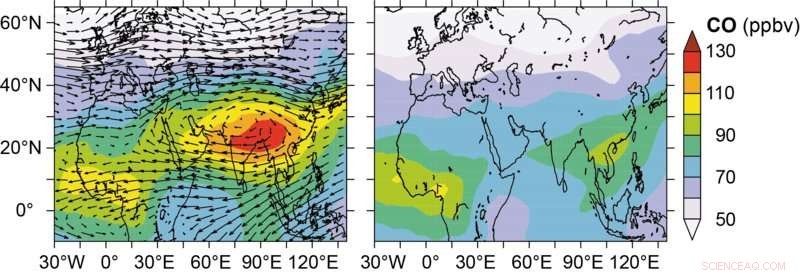Sydasiatisk monsun renser effektivt luften for forurenende stoffer, men distribuerer dem også over hele kloden

En enorm sky af forurening over Sydasien:Den atmosfæriske brune sky skabes i vintermånederne hvert år ved forbrænding af biomasse og fossile brændstoffer. Kredit:NASA, Jeff Schmaltz, LANCE/EOSDIS hurtig reaktion
Det samme fænomen gentager sig hvert år. I den tørre sæson, om vinteren, afbrænding af fossile brændstoffer og biomasse i Sydasien skaber en enorm forureningsdis:Den atmosfæriske brune sky. Hvordan og hvorfor det forsvinder, så snart regntiden starter om foråret, er nu blevet afklaret af et internationalt hold af forskere ledet af Max Planck Institute for Chemistry. Resultatet er, at tordenvejr trækker sig op, lyn og kemiske reaktioner øger atmosfærens selvrensende kraft, tillader atmosfæriske forurenende stoffer effektivt at blive vasket ud af luften. Imidlertid, de forurenende stoffer, der ikke elimineres, transporteres ind i den øvre troposfære af monsunen og spredes derefter over hele verden.
Intet vejrfænomen definerer Sydasien så meget som monsunen:dette enorme cirkulationssystem fører til tørhed om vinteren, men bringer intens nedbør om sommeren. Sommermonsunen skabes ved opvarmning af luftmasser over det indiske subkontinent, og den varme luft stiger op. Som resultat, fugtig havluft trækkes ind og strømmer over land mod Himalaya. Dybe tordenskyer producerer regn over regionen i måneder, sikring af vandforsyning og sikring af høst.
Atmosfæriske forskere har længe haft mistanke om, at de stigende luftmasser også transporterer forurening højt op i atmosfæren, selv over regnskyerne. "Vi forventede, at gasformige og partikelformige forurenende stoffer overføres til en anticyklon, en enorm cirkulation af vinde med uret, som dannes over skyerne over Sydasien som følge af tordenvejrskonvektionen, " siger Jos Lelieveld, Direktør ved Max Planck Institute for Chemistry. Geografisk set, landene i Bhutan, Nepal, Myanmar, Bangladesh, Tibet, Indien, Sri Lanka, Pakistan og Afghanistan er en del af Sydasien. I denne region, Udledningen af nitrogenoxid og svovldioxid fra afbrænding af kul og andre fossile brændstoffer er steget med halvtreds procent i løbet af det seneste årti. Imidlertid, forureningsskyen er også drevet af andre kilder, især forbrændingen af biomasse i regionens store befolkning.
Monsunen transporterer atmosfæriske forurenende stoffer og eliminerer dem
Bevis på, at den sydasiatiske monsun faktisk transporterer forurenende stoffer gennem skylaget så højt som stratosfæren, er nu blevet leveret af en omfattende ekspedition med forskningsflyet HALO:i 2015, Max Planck Instituttet for Kemi, sammen med kolleger fra Forschungszentrum Jülich, Karlsruhe Institute of Technology og German Aerospace Center (DLR), lancerede missionen "Oxidation Mechanism Observations" (OMO). "Vores forskningsflyvninger afslørede, at monsunen også effektivt fjerner forurenende stoffer fra atmosfæren, " sagde ekspeditionsleder Lelieveld. De forurenende stoffer transporteres op fra overfladen og omdannes hurtigt til forbindelser, der lettere fjernes af regn.
Det videnskabelige holds undersøgelse afslørede således monsunens dyd, men også dens ulemper:en stor del af Sydasiens forurenende stoffer bevæger sig op over monsunskyer ind i anticyklonen. Der akkumuleres de og fordeles derefter rundt om på kloden. For eksempel, næsten ti procent af Sydasiens svovldioxidemissioner når stratosfæren, hvilket igen har effekter på klimaet og ozonlaget. Monsunen repræsenterer derfor ikke kun en form for effektiv forurenende vaskemaskine, men bidrager samtidig til global atmosfærisk forurening.
HALO afslører kilderne til atmosfærisk forurening og nedbrydningsprocesserne
Forskerne opnåede disse resultater fra målinger i anticyklonen:i juli og august fløj de op til 15 kilometer ind i monsunens udstrømning, mellem det østlige Middelhav og Det Indiske Ocean, og analyserede atmosfærens sammensætning med forskningsflyet HALO. De passerede regioner i Mellemøsten, Middelhavet og Nordafrika for at undersøge omfanget af fænomenet.

Modelling results illustrate atmospheric pollution over South Asia. The left figure shows carbon monoxide emissions (CO) at an altitude of 12 to 17 kilometres, on the right is the same visualization but without emissions from South Asia. The figure on the left also shows the winds over the region, clearly revealing the anticyclone created by the monsoon. Credit:MPI for Chemistry
During the survey flights, they identified numerous chemical compounds in order to understand the sources of atmospheric pollution and the chemical processes in the atmosphere:sulphur dioxide and nitrogen oxides, ozon, aerosoler, chlorine-containing molecules, hydrocarbons and their degradation products.
More carbon monoxide and sulphur dioxide, but also more hydroxyl
For eksempel, the measurement flights revealed that carbon monoxide and sulphur dioxide concentrations within the anticyclone were significantly increased compared to outside. "The large amounts of sulphur dioxide originate from combustion processes by human activities and are much higher than natural background concentrations, " says atmospheric researcher Hans Schlager of the DLR. This, på tur, means that a substantial proportion of atmospheric pollution is transported to altitudes up to 15 kilometres. Ud over, the researchers were able to demonstrate that India represents a significant source of pollutants. It was previously assumed that much of the emissions come from China, because the monsoon's area of influence extends as far as East Asia.
"We also analysed the levels of hydroxyl radicals and found significantly higher concentrations within the anticyclone than outside it, " relates Max Planck researcher Hartwig Harder, who was present during the entire expedition. The hydroxyl molecule (OH) is better known as the atmospheric cleansing agent because it is highly reactive and efficiently oxidizes pollutants. Chemically, this has two effects:on the one hand, their solubility and thus their ability to lock on to existing airborne particles change, making them easier to wash out of the atmosphere by precipitation. På den anden side, the oxidized molecules can combine to form new aerosols. Because the anticyclone expands widely and disperses the particles, this effect can impact the global climate.
More atmospheric cleaners thanks to lightning
The atmospheric cleanser OH primarily forms when ozone and water are broken down by sunlight. Once the radical has reacted with pollutants, it is generally lost. Imidlertid, if nitrogen oxides are present, it is recycled and can purify repeatedly, explains the atmospheric chemist Andreas Hofzumahaus of Forschungszentrum Jülich. Nitrogen oxides are formed not only by the combustion of diesel fuel, but also by lightning in the atmosphere. Because lightning frequently occurs during monsoon thunderstorms, the self-cleaning power at 15 kilometres altitude is maintained despite the atmospheric pollution. Ifølge forskerne, even much more OH is recycled than is primarily formed.
Det betyder, derefter, that the monsoon weather phenomenon not only pumps pollutants high into the atmosphere, but simultaneously provides a cleaning mechanism to remove some of those pollutants again.
This explanation was confirmed by the results of an established numerical model system, which computes the chemical processes in the atmosphere globally. Based on this model, it is possible to determine, blandt andet, the concentrations of individual chemical compounds such as carbon monoxide, svovldioxid, kulbrinter, nitrogen oxides and those of the OH radical – verified based on the measurements. The OH decreases by a factor of two to three if the scientists do not take into account the nitrogen oxides produced by lightning in the model.
Because it can be assumed that pollutant emissions in the region will continue to increase in future years, the researchers headed by Jos Lelieveld are interested in how the two faces of the Janus-headed South Asian monsoon will develop in the future:Will the cleaning and transport mechanism continue to exist side by side or will they be tilted in one direction or the other?
 Varme artikler
Varme artikler
-
 Uddød stil af pladetektonik forklarer tidlige Jordens flade bjergeDen 1,4 milliarder år gamle sten i Labrador, Canada, er nogle af de mest velstuderede rester af proterozoiske bjerge. Kredit:Christopher Spencer, CC-BY-NC-4.0 Geokemiske og geologiske optegnelser
Uddød stil af pladetektonik forklarer tidlige Jordens flade bjergeDen 1,4 milliarder år gamle sten i Labrador, Canada, er nogle af de mest velstuderede rester af proterozoiske bjerge. Kredit:Christopher Spencer, CC-BY-NC-4.0 Geokemiske og geologiske optegnelser -
 Magma transportbånd drev verdens længste udbrud af supervulkanerEt lille udbrud af Mount Rinjani, med vulkanske lyn. Sted:Lombok, Indonesien. Kredit:Oliver Spalt, Wikipedia. International forskning ledet af geologer fra Curtin University har fundet ud af, at e
Magma transportbånd drev verdens længste udbrud af supervulkanerEt lille udbrud af Mount Rinjani, med vulkanske lyn. Sted:Lombok, Indonesien. Kredit:Oliver Spalt, Wikipedia. International forskning ledet af geologer fra Curtin University har fundet ud af, at e -
 Hvordan urbane lydlandskaber påvirker mennesker og dyreliv, og hvad der kan have ændret sig i stil…Sorttuftede silkeaber i Brasilien undgår støjende levesteder, selv når der er masser af mad. Kredit:Shutterstock Trafikkens kedelige brøl, hundenes gøen i baghaven og skriben fra kakaduer i skumri
Hvordan urbane lydlandskaber påvirker mennesker og dyreliv, og hvad der kan have ændret sig i stil…Sorttuftede silkeaber i Brasilien undgår støjende levesteder, selv når der er masser af mad. Kredit:Shutterstock Trafikkens kedelige brøl, hundenes gøen i baghaven og skriben fra kakaduer i skumri -
 Ilt kunne have været tilgængeligt for livet så tidligt som for 3,5 milliarder år sidenCyanobakterier tæt på. Kredit:Dr. Norbert Lange / Shutterstock Mikrober kunne have udført iltproducerende fotosyntese mindst en milliard år tidligere i Jordens historie end tidligere antaget. Fun
Ilt kunne have været tilgængeligt for livet så tidligt som for 3,5 milliarder år sidenCyanobakterier tæt på. Kredit:Dr. Norbert Lange / Shutterstock Mikrober kunne have udført iltproducerende fotosyntese mindst en milliard år tidligere i Jordens historie end tidligere antaget. Fun
- Hurtigere, mere præcis, mere stabil:Undersøgelse optimerer grafenvækst
- Det er muligt at opnå ren luft for alle
- Havvand giver de første gram gulkage:Garnlignende materiale opsamler den største mængde uran til …
- Ny laserteknologi muliggør mere følsomme gravitationsbølgedetektorer
- Nulstilling af fødevaresikkerhed, efterhånden som landbrugets virkninger af klimakrisen bliver mer…
- Sådan beregnes Bond Energy


